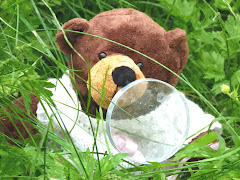Saturday 19 December 2009
Acid Oceans Experiment
Hi
Bella sent me another message, this time about acids and alkali, you may remember we were talking about pH yesterday. As I have talked about on several occasions already, global warming is heating up the oceans causing the polar ice caps to melt. Bella told me that global warming is also causing more carbon dioxide in the oceans which is making the water more acid and over time will dissolve the shells of any hard bodied animal such as coral and sea snails.
Bella suggested an experiment you can have a go at with the help of an adult.
All you need is some chalk and some clear vinegar and a glass.
1. Fill the glass one-half full with vinegar.
2. Add the piece of chalk to the glass.
3. Observe what happens to the chalk.
After a short time, bubbles will start rising from the chalk. If you leave it in the glass long enough, the chalk will completely break apart. The chemical name for vinegar is acetic acid and chalk is made of a mineral called limestone. The acetic acid and limestone form a chemically reaction when put together. One of the new substances that forms in this reaction is carbon dioxide gas. The bubbles rising from the chalk are the carbon dioxide gas.
This is a very speeded up version of what acid oceans will do to the shells and hard bodies of animals with a calcium shell. It will not happen so dramatically as the oceans are less acidic, but overtime the shells will weaken as they begin to dissolve.
Bella sent me another message, this time about acids and alkali, you may remember we were talking about pH yesterday. As I have talked about on several occasions already, global warming is heating up the oceans causing the polar ice caps to melt. Bella told me that global warming is also causing more carbon dioxide in the oceans which is making the water more acid and over time will dissolve the shells of any hard bodied animal such as coral and sea snails.
Bella suggested an experiment you can have a go at with the help of an adult.
All you need is some chalk and some clear vinegar and a glass.
1. Fill the glass one-half full with vinegar.
2. Add the piece of chalk to the glass.
3. Observe what happens to the chalk.
After a short time, bubbles will start rising from the chalk. If you leave it in the glass long enough, the chalk will completely break apart. The chemical name for vinegar is acetic acid and chalk is made of a mineral called limestone. The acetic acid and limestone form a chemically reaction when put together. One of the new substances that forms in this reaction is carbon dioxide gas. The bubbles rising from the chalk are the carbon dioxide gas.
This is a very speeded up version of what acid oceans will do to the shells and hard bodies of animals with a calcium shell. It will not happen so dramatically as the oceans are less acidic, but overtime the shells will weaken as they begin to dissolve.
Subscribe to:
Post Comments (Atom)







No comments:
Post a Comment